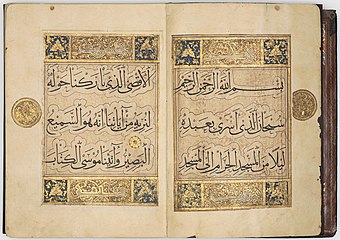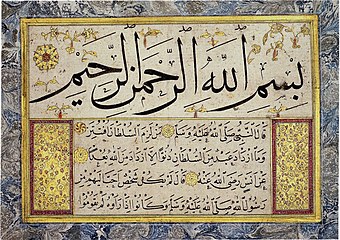Muhaqqaq
Muhaqqaq is one of the main six types of
Arabic word muḥaqqaq (محقَّق) means "consummate" or "clear", and originally was used to denote any accomplished piece of calligraphy.[2]
Often used to copy maṣāḥif (singular muṣḥaf, i.e. loose sheets of
Mameluk era (1250–1516/1517).[4] In the Ottoman Empire, it was gradually displaced by Thuluth and Naskh; from the 18th century onward, its use was largely restricted to the Basmala in Hilyas.[5]
History
The earliest reference to muḥaqqaq writing is found in the Abbasid era to denote a specific writing style.[6] Master calligraphers like Ibn Muqla and Ibn al-Bawwab contributed to the development of this and other scripts, and defined its rules and standards within Islamic calligraphy.[7]
Gallery
-
Double-page from the Qur'an in muhaqqaq dedicated to Abu’l-Qasim Harun ibn ‘Ali ibn Zafar, the vizier of Özbeg (r 1210–1225), the last atabak of Azerbaijan. Khalili Collection of Islamic Art
-
Double-page from the Qur'an in muhaqqaq copied by Yaqut al-Musta'simi. Baghdad, 1282/1283. Khalili Collection of Islamic Art
-
Double-page from the Qur'an in muhaqqaq copied by Ahmad al-Suhrawardi. Baghdad, 1307/1308. Turkish and Islamic Arts Museum
-
Opening pages from the Qur'an in muhaqqaq copied by Ali ibn Muhammad al-Mukattib al-Ashrafi. Cairo, 1372. Egyptian National Library
-
Page from the Qur'an in muhaqqaq copied for Timur by Umar Aqta. Samarkand, c. 1400. Museum of Islamic Art, Doha
-
Album Leaf from a Muraqqa by Hâfiz Osman with basmala in muhaqqaq (upper panel). Istanbul, 1693/1694. Museum of Islamic Art, Berlin
See also
Notes
References
- Nassar Mansour (author), Mark Allen (ed.): Sacred Script: Muhaqqaq in Islamic Calligraphy, I.B.Tauris & Co Ltd, New York 2011, ISBN 978-1-84885-439-0
Wikimedia Commons has media related to Muhaqqaq style.







